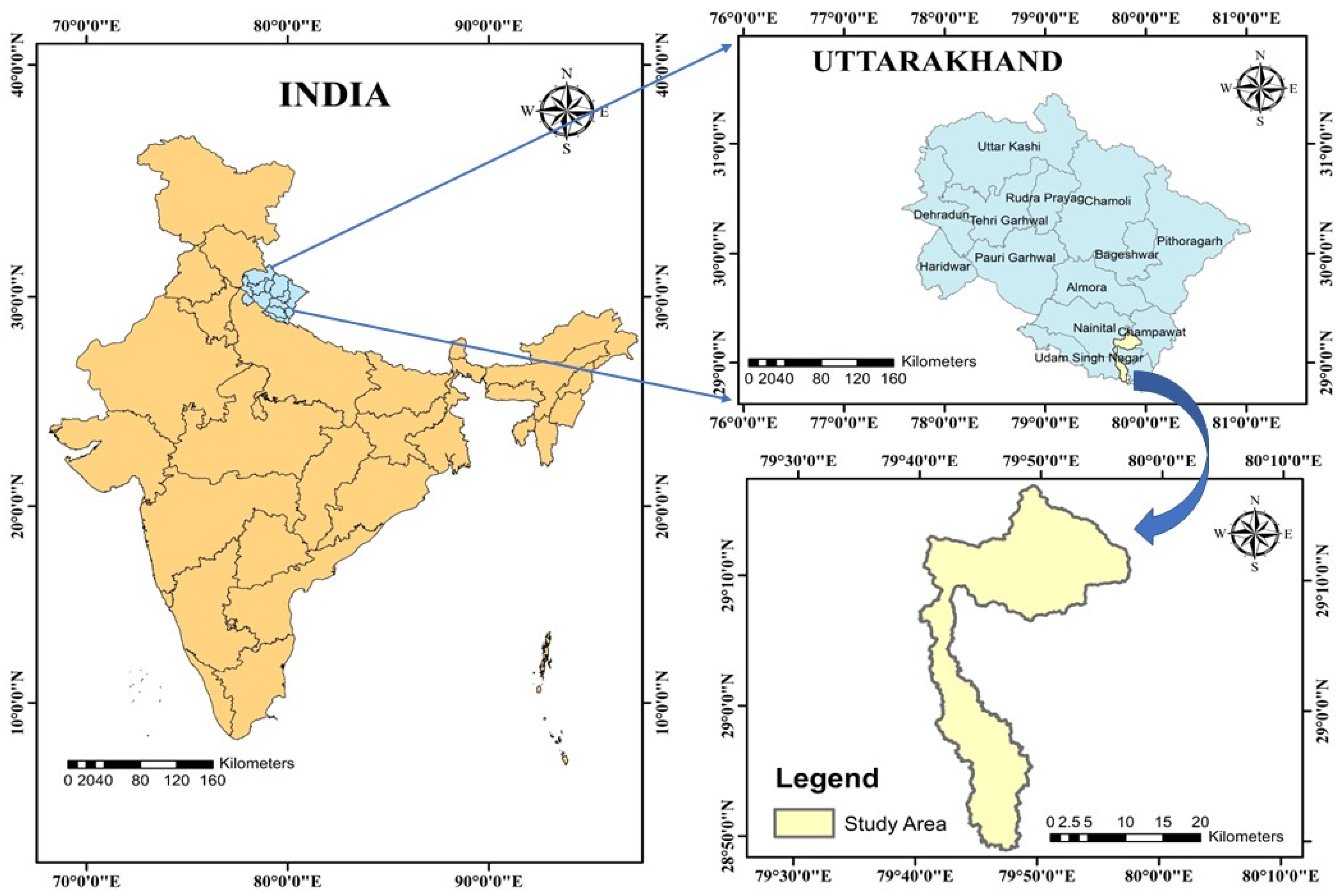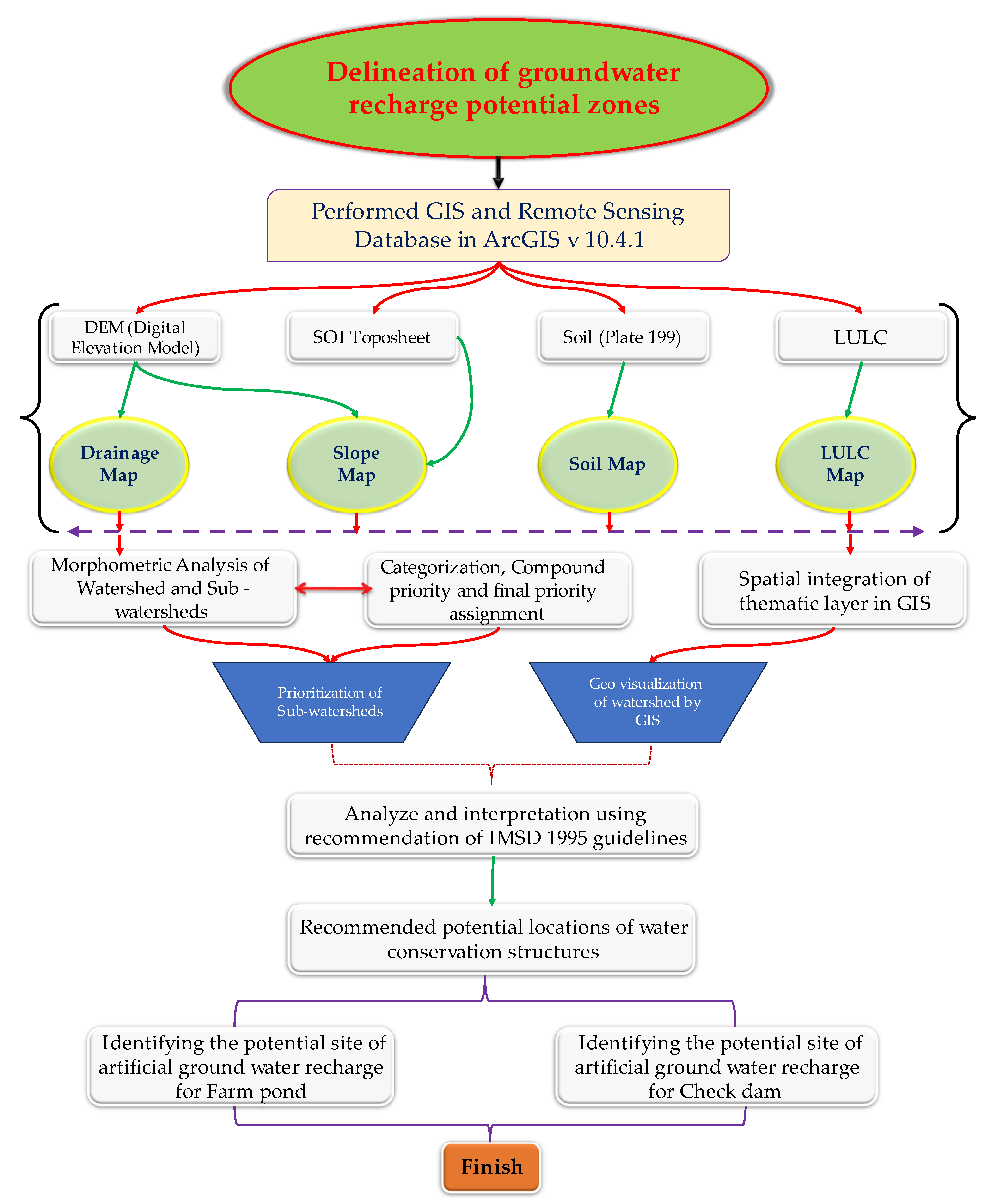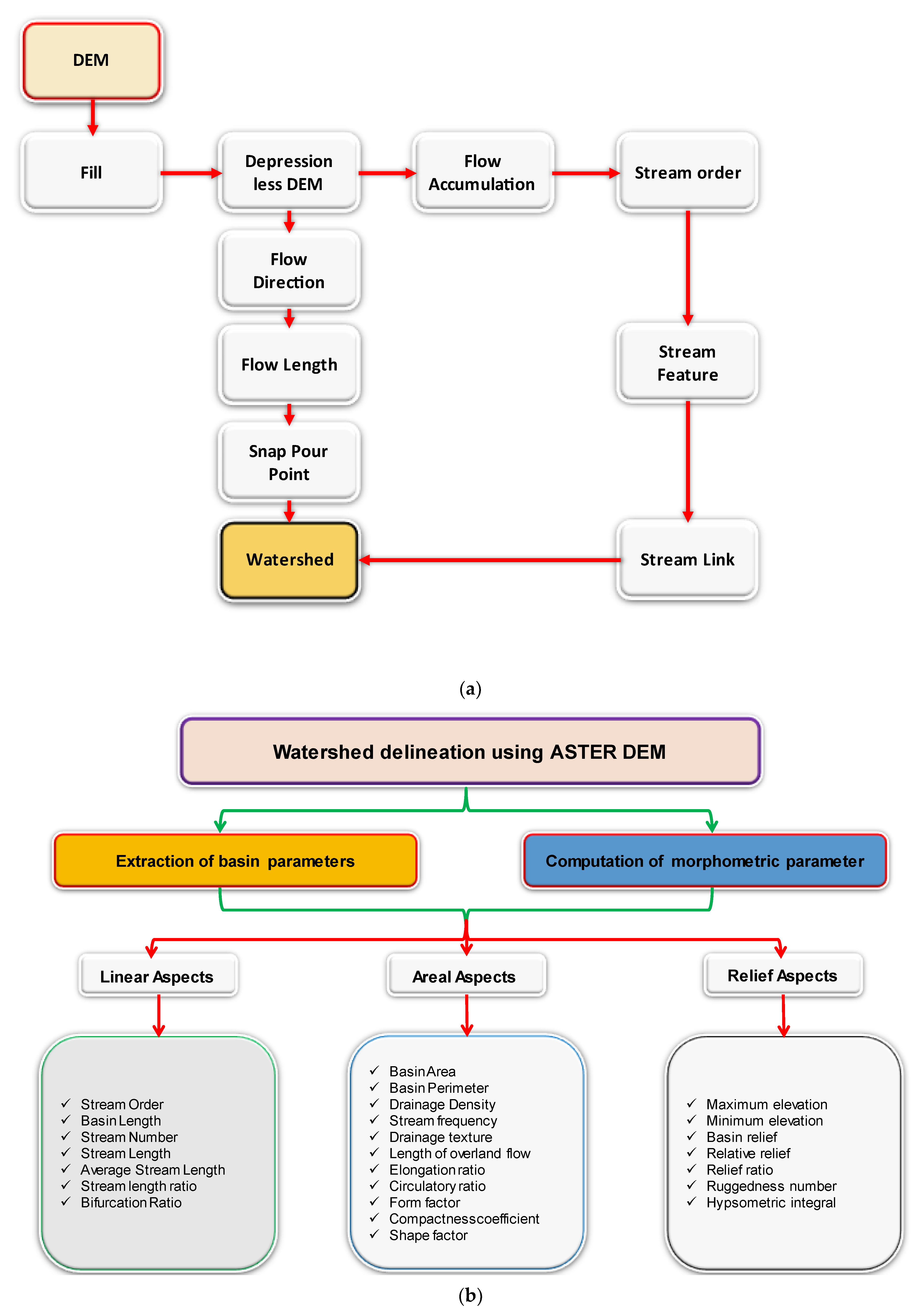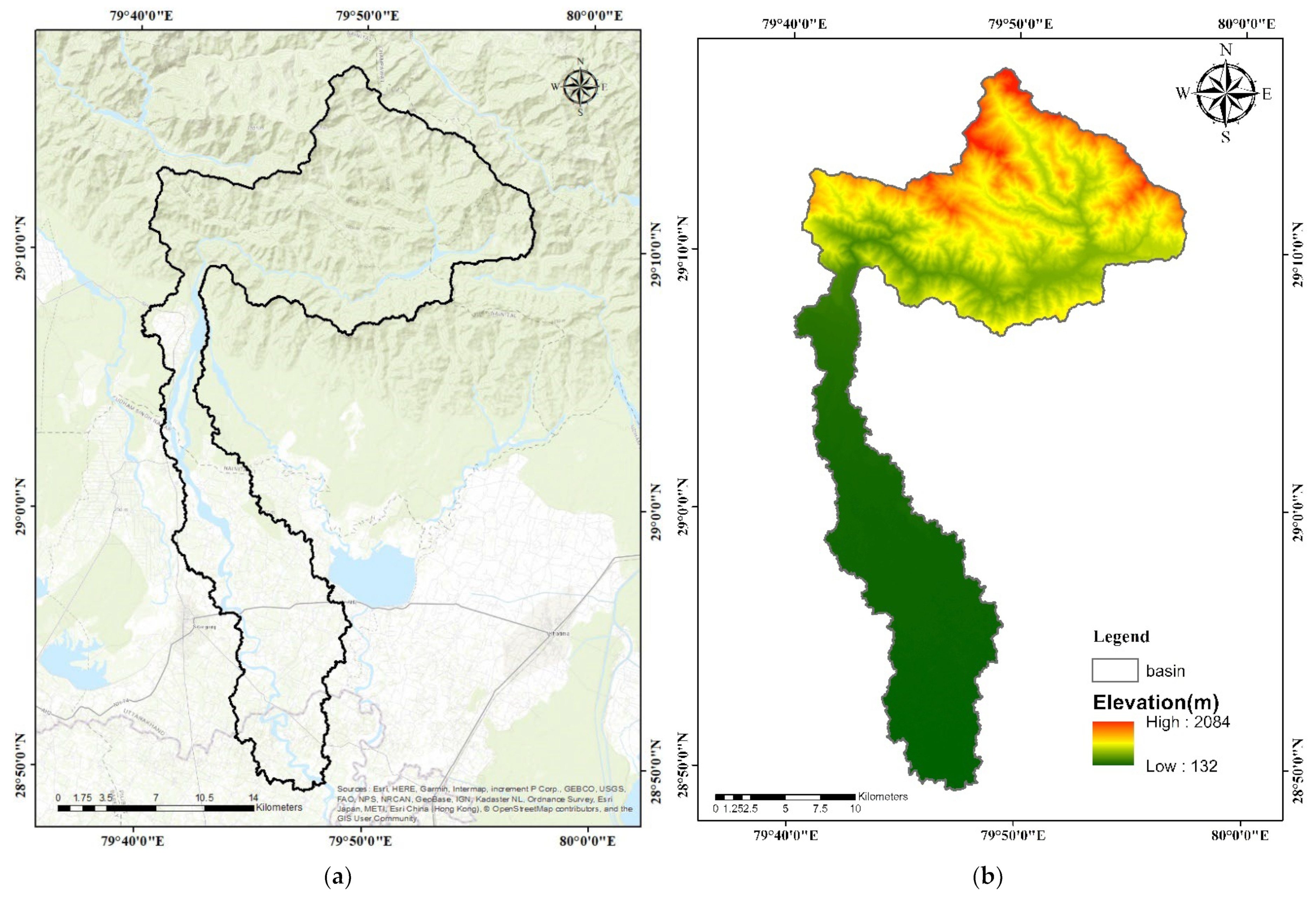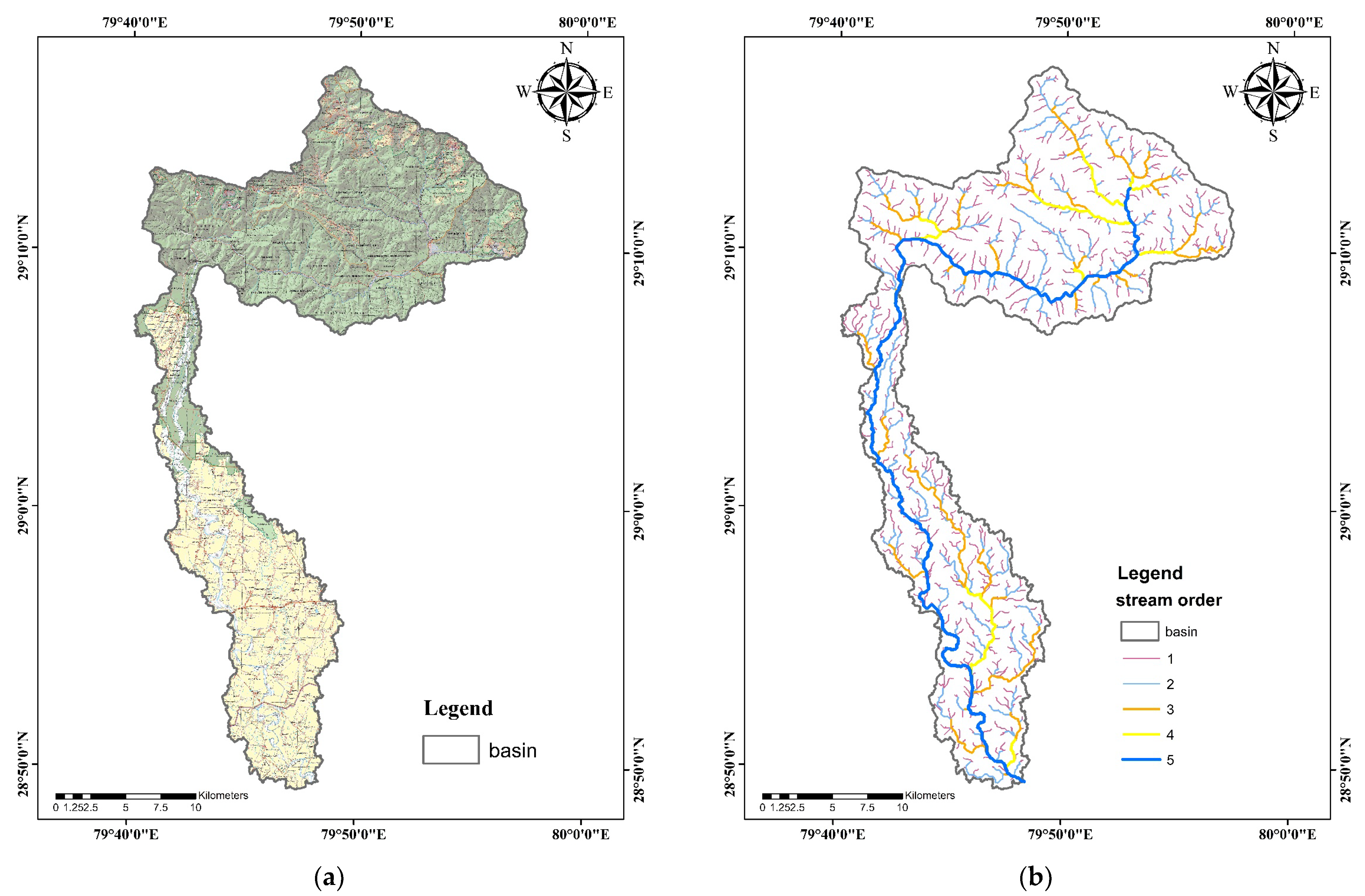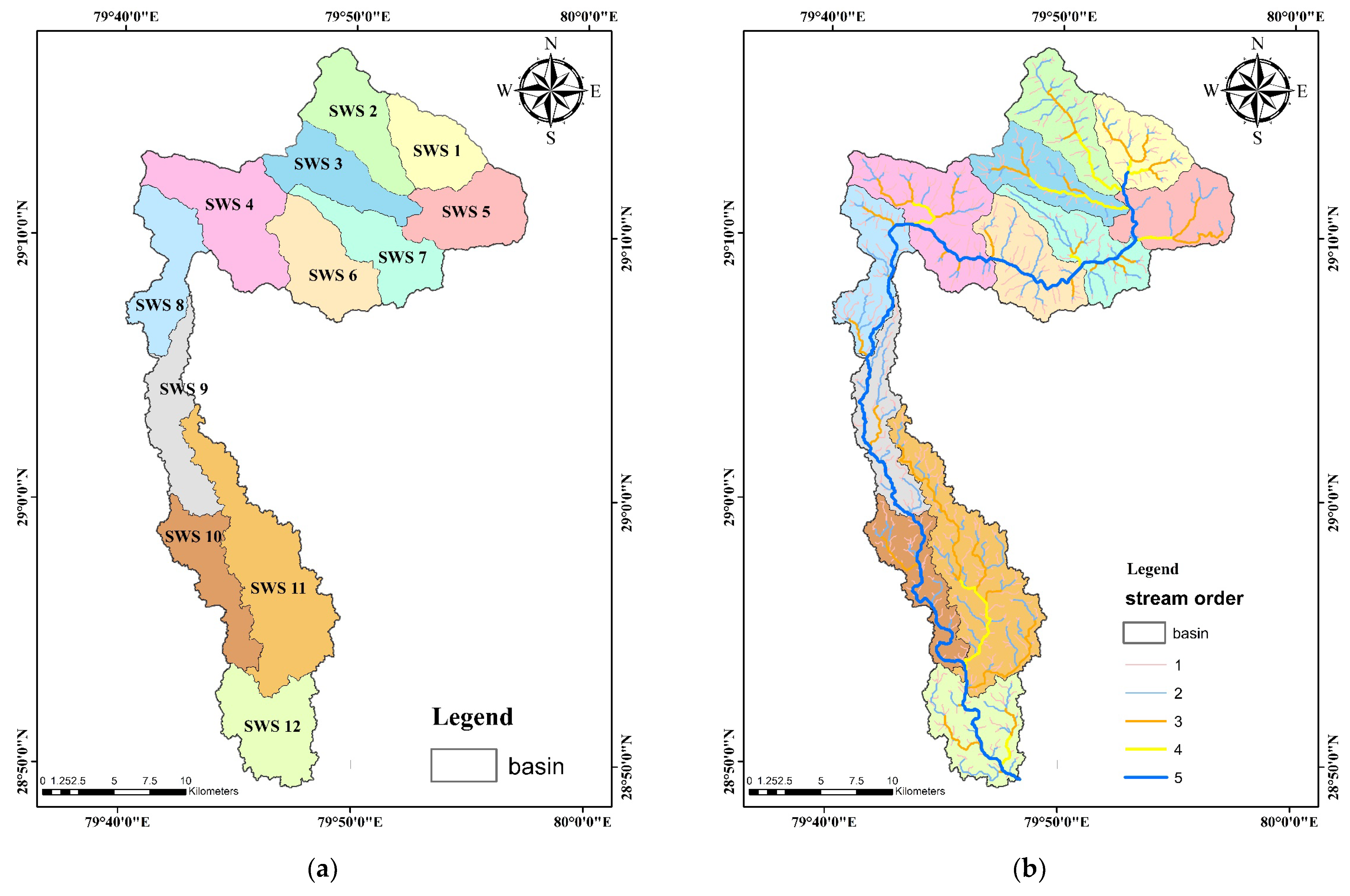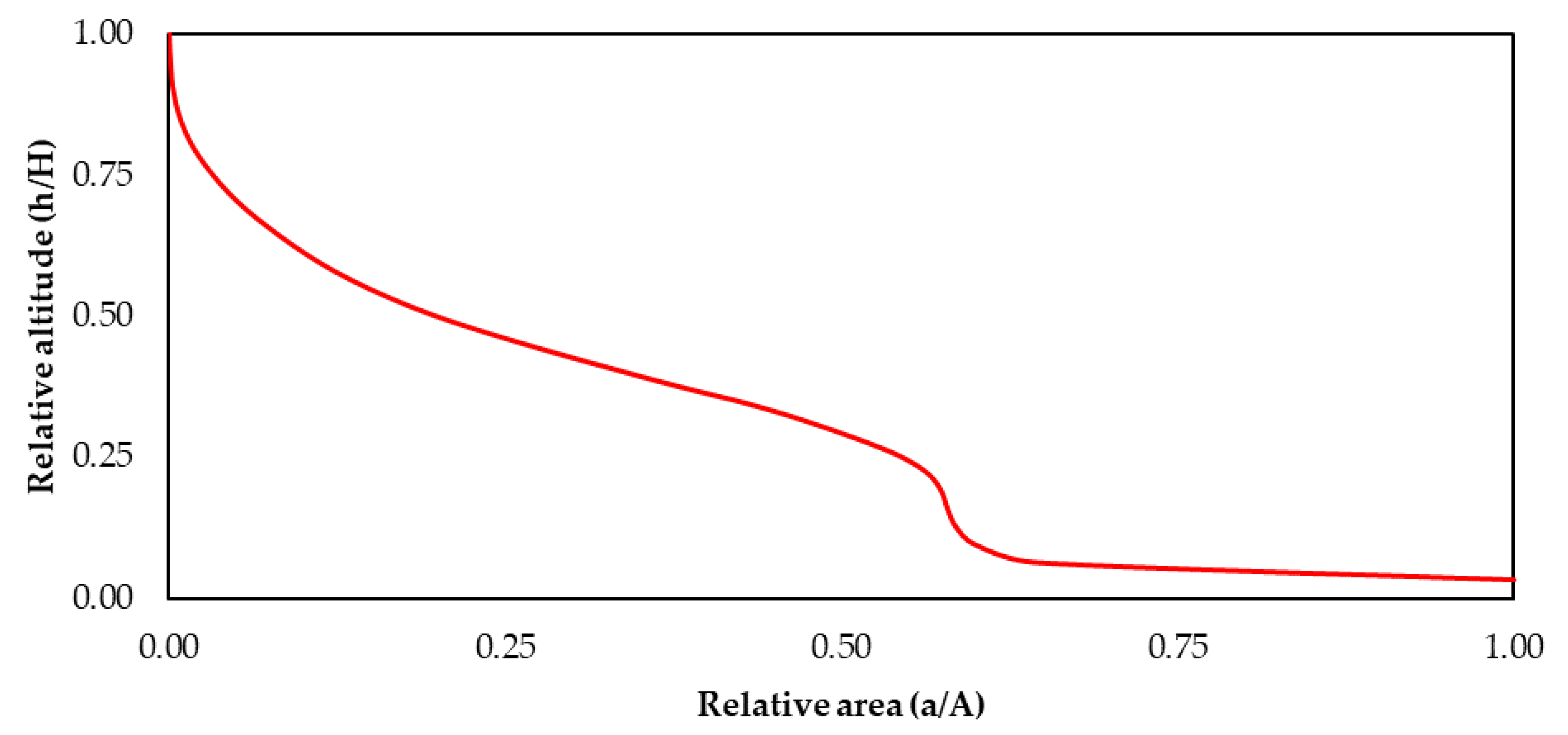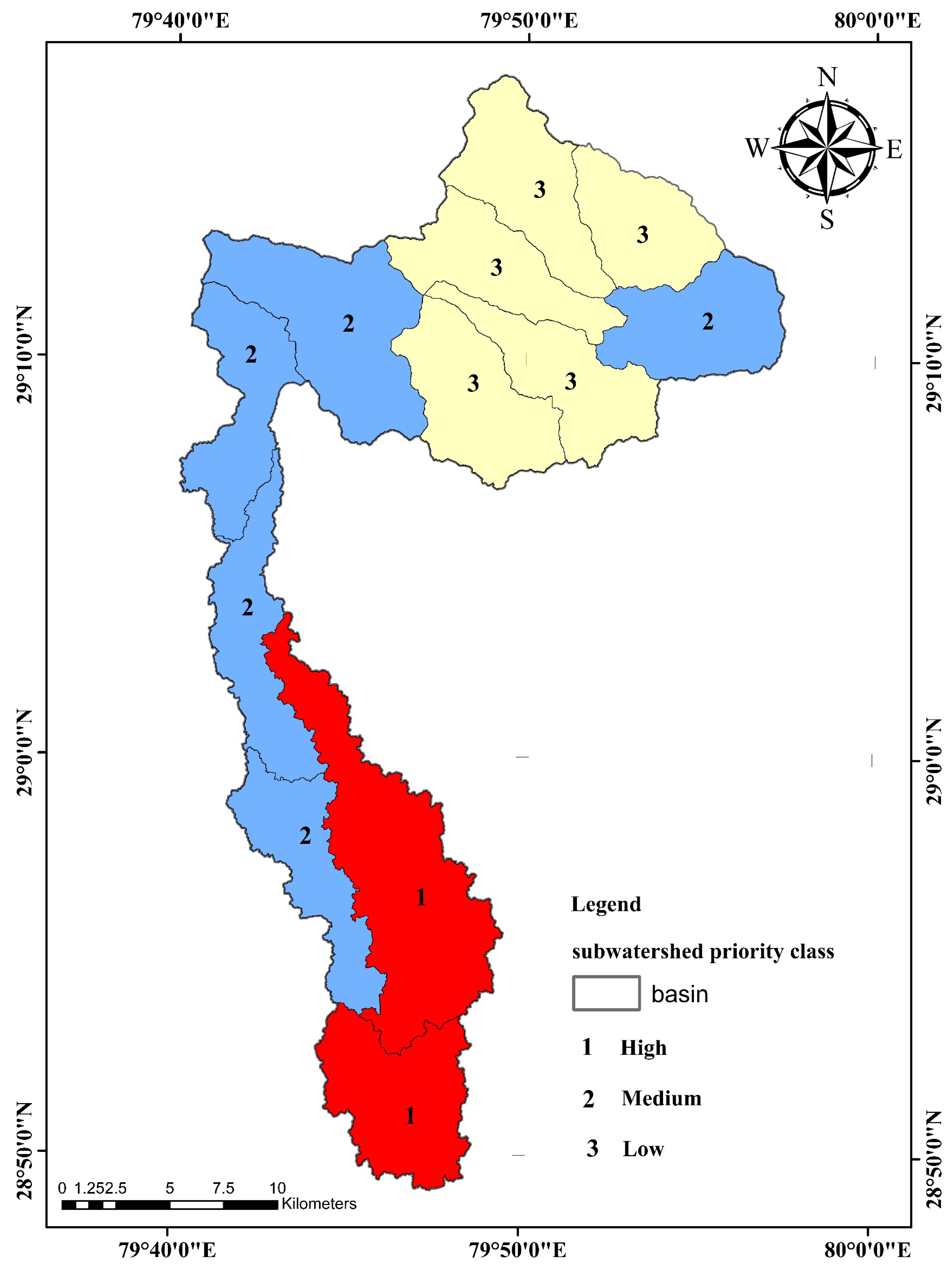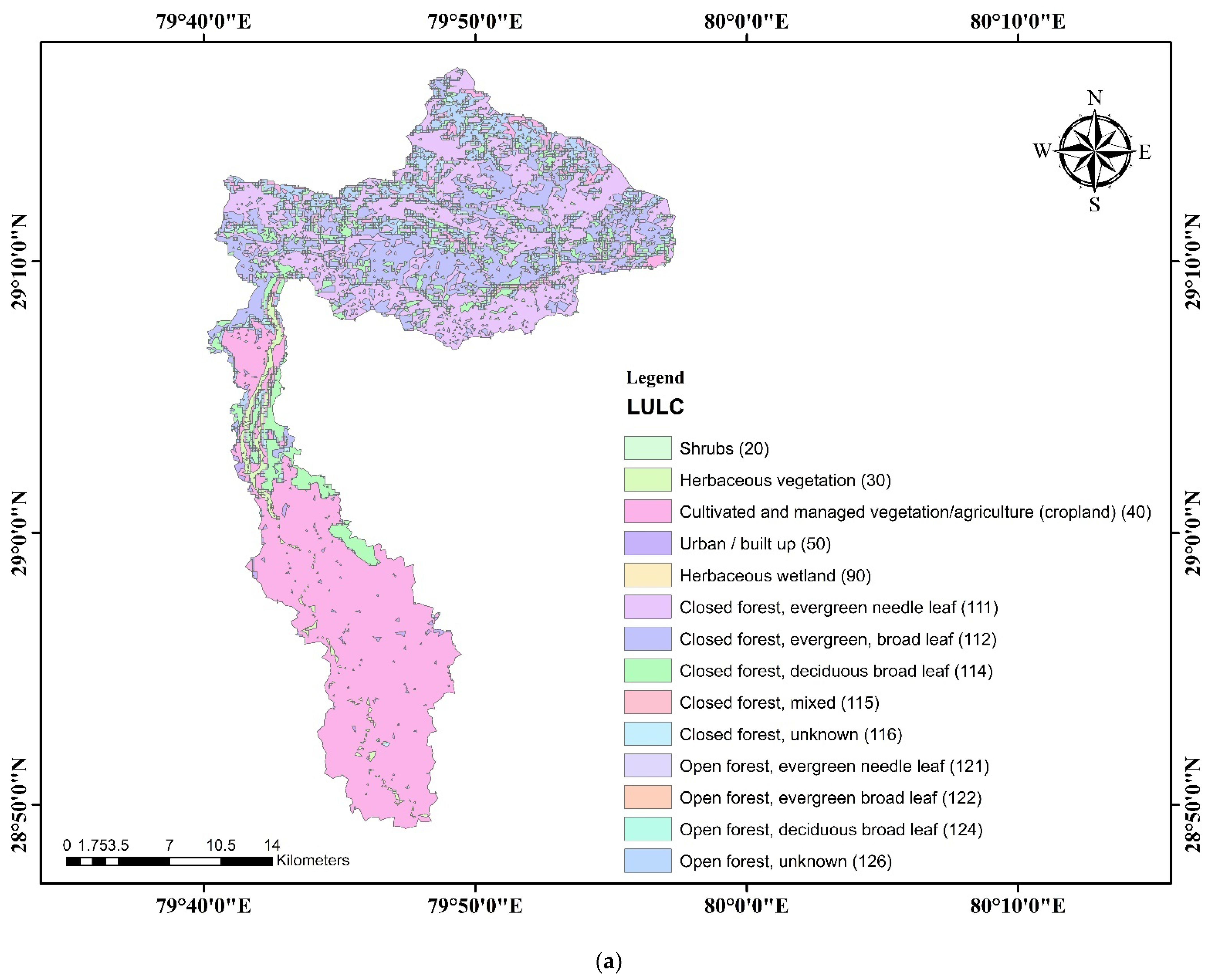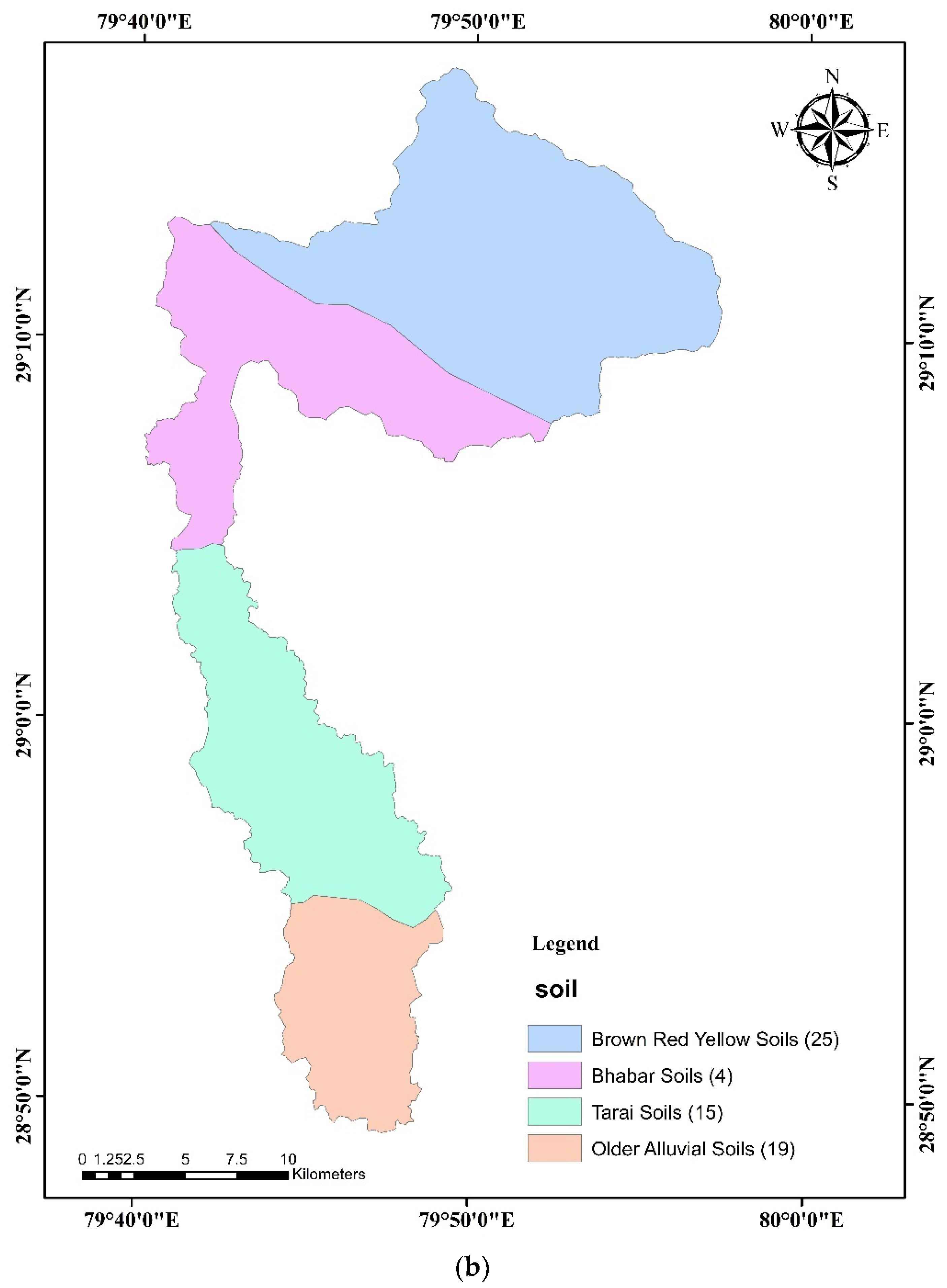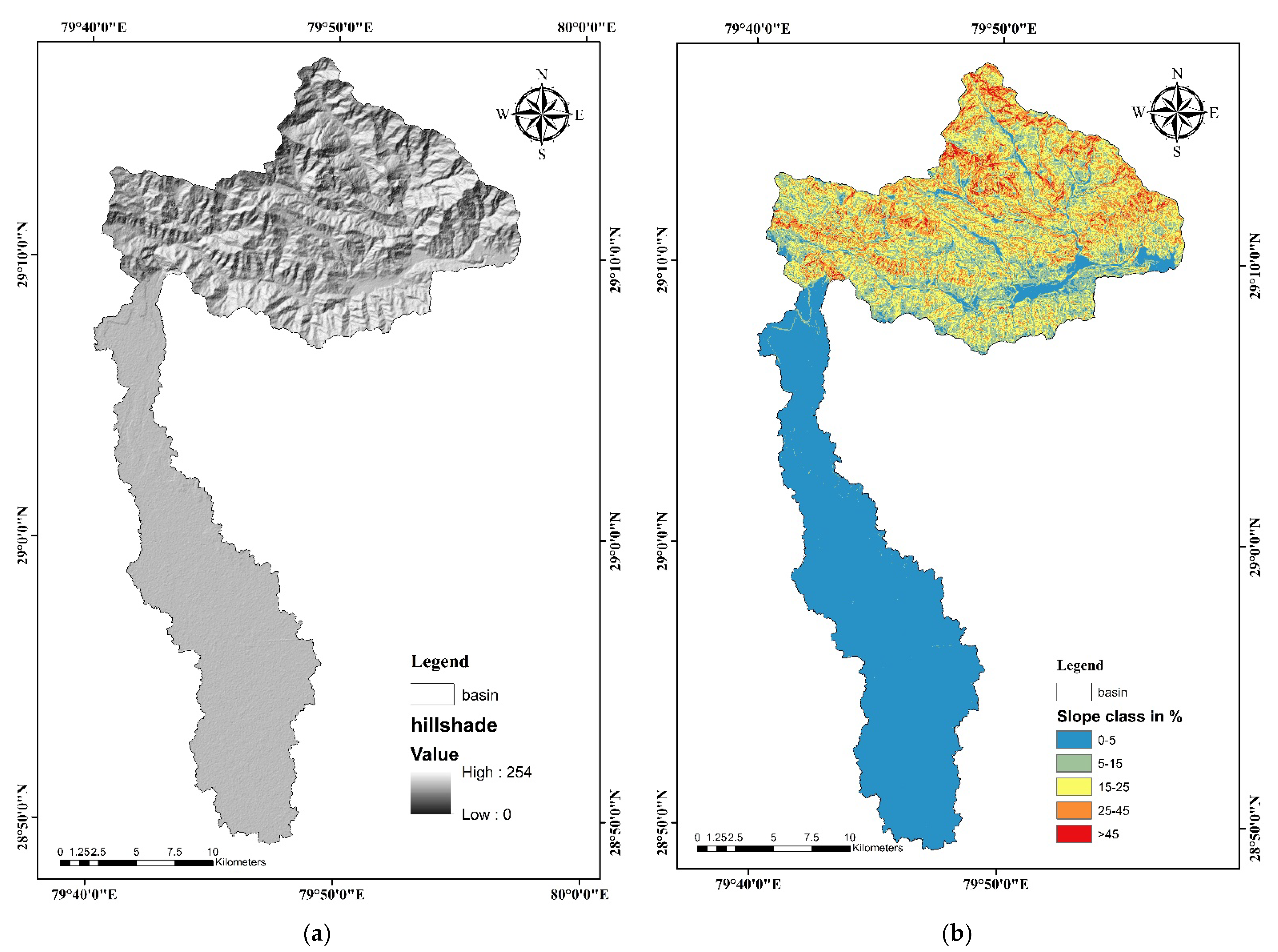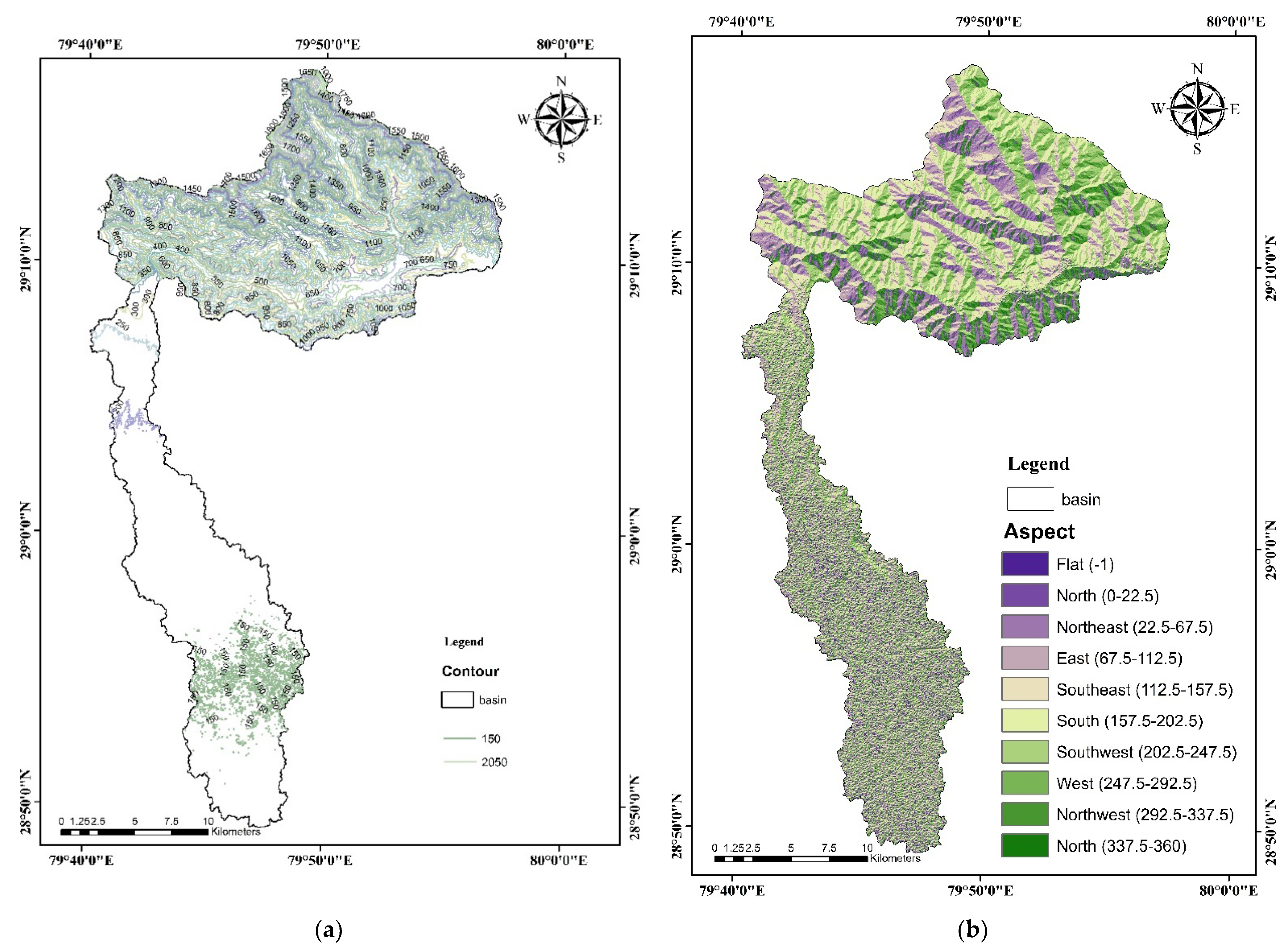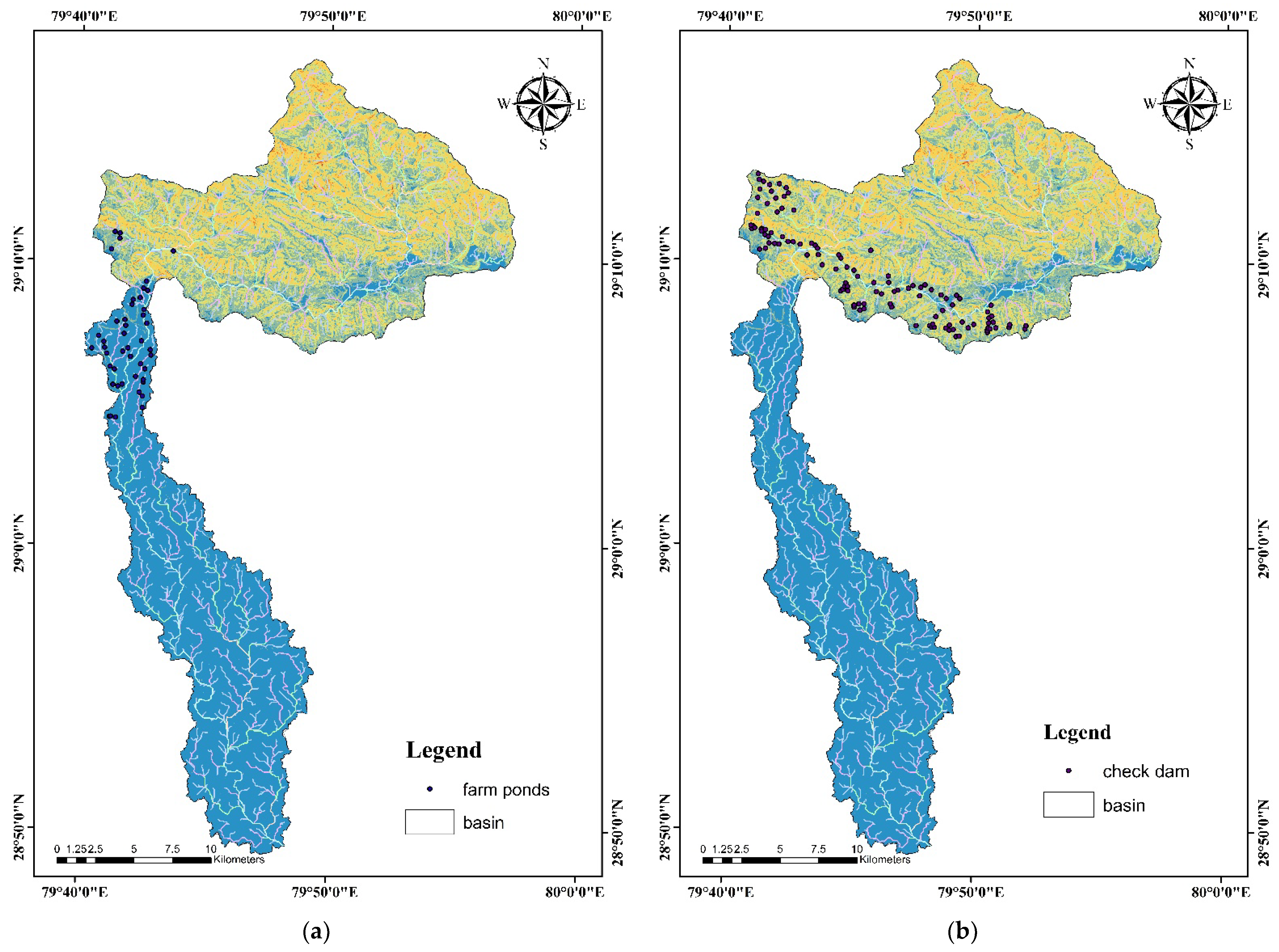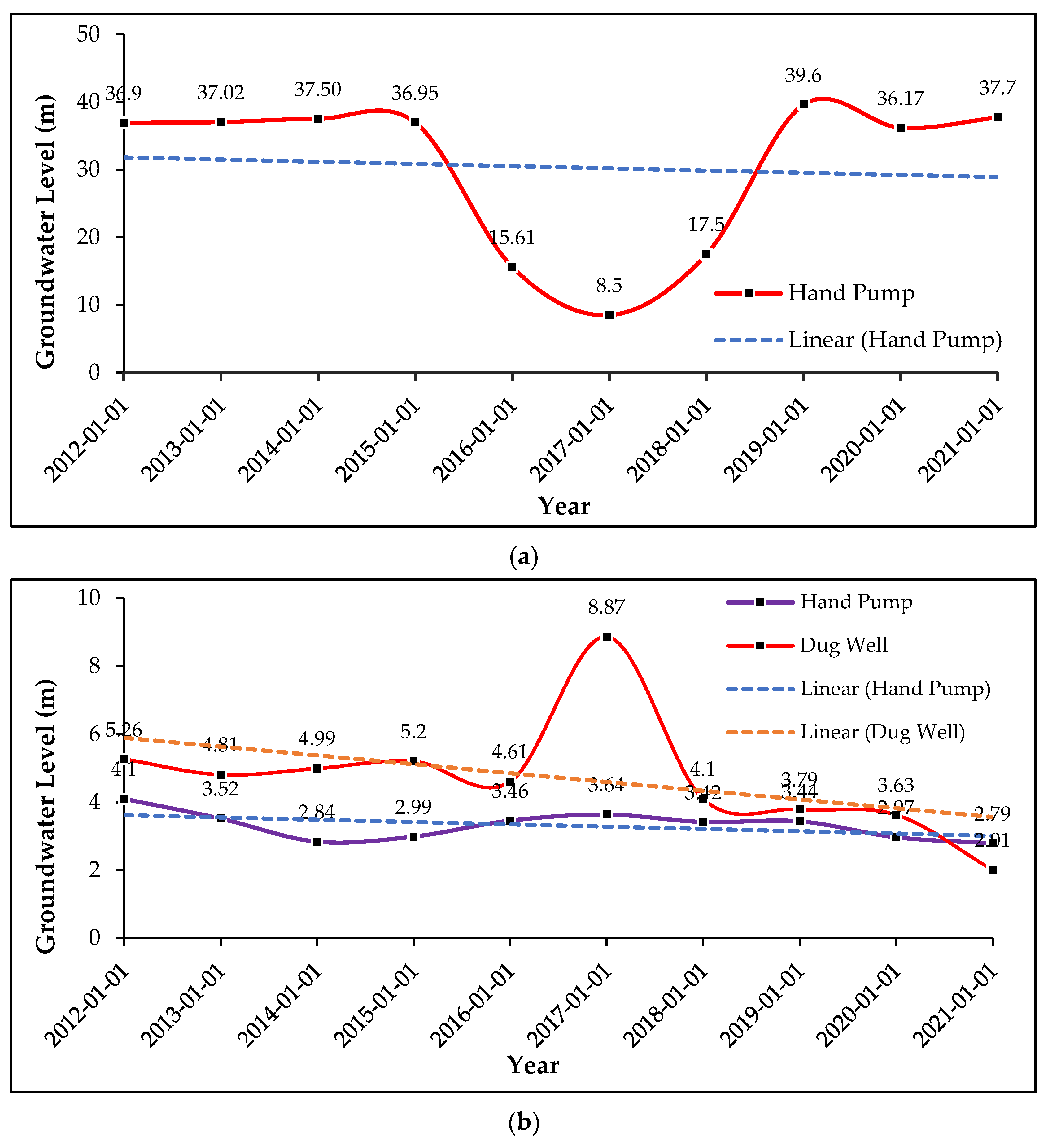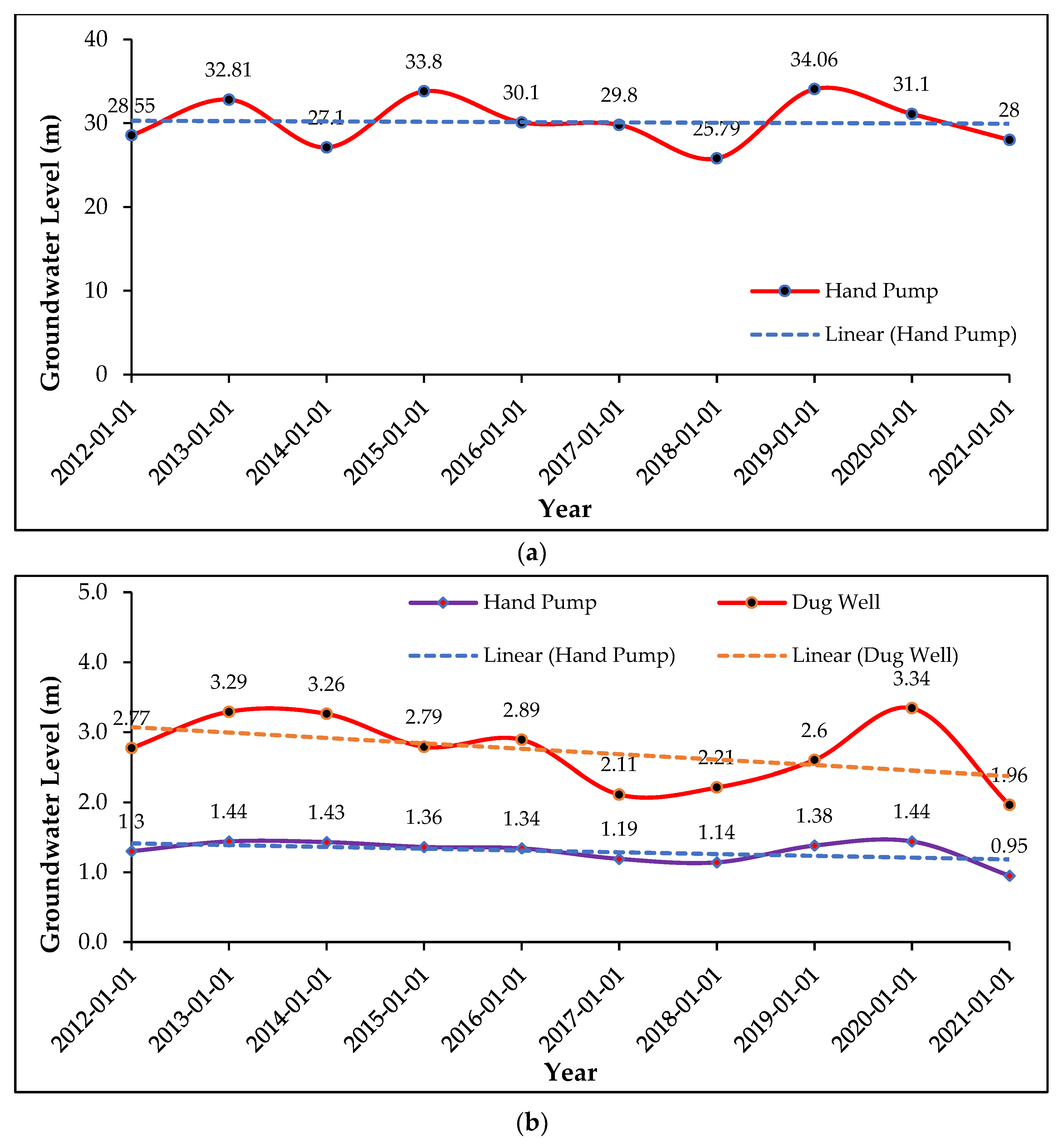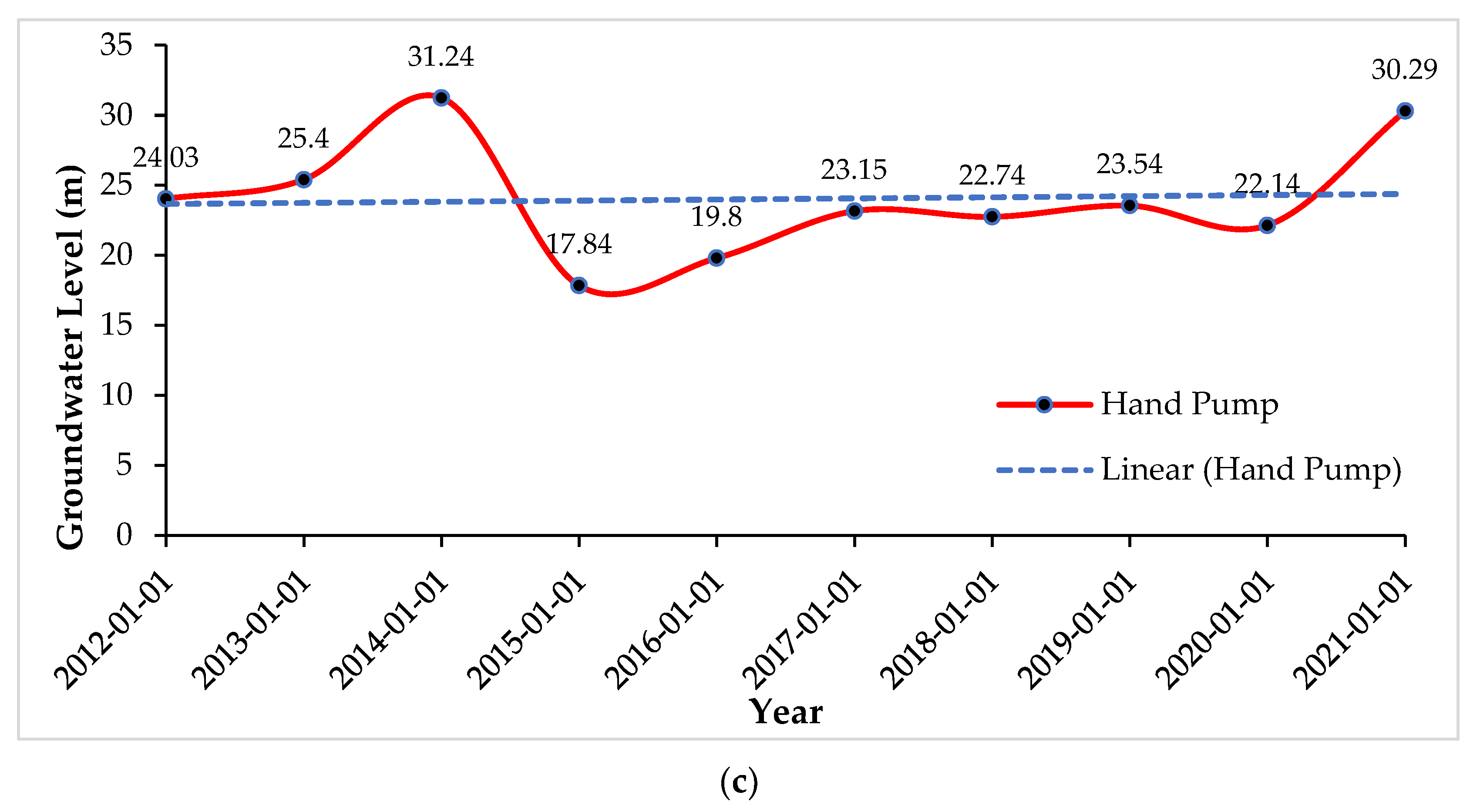1. Introduction
In many areas of India, groundwater is an essential water source for irrigation, drinking, and various other applications [
1,
2,
3]. More than 90% of rural and about 30% of urban residents have access to drinking water from groundwater [
4,
5,
6]. Recent increases in domestic, agricultural, and industrial water use have placed additional pressure on the world’s groundwater resources [
7,
8]. Acknowledging the significance of recharge procedures will aid in upholding the equilibrium between water resource supply and demand. It is crucial to understand that groundwater recharge zones (GRPZs), where the ground surface allows for groundwater infiltration and percolation, have potential [
9]. As a result, water may permeate the soil, enter the vadose zone, or continue to flow unhindered [
10,
11,
12]. Naturally, replenishing groundwater reservoirs is a laborious process and is frequently insufficient to keep up with the country’s excessive and ongoing exploitation of groundwater resources.
Consequently, the groundwater level has fallen, and many regions have depleted groundwater supplies. Artificial recharge operations are primarily targeted to enhance the natural circulation of surface water into groundwater reservoirs using appropriate engineering techniques. Even if rainfall is relatively high in hilly places, water scarcity is generally felt in the post-monsoon season. Most accessible water is lost as surface runoff. During the post-monsoon period, springs are the primary water source of this region, and the discharge of these springs is also depleted. Rainwater harvesting and surface storage at appropriate positions in the recharge zones can improve recharge in such areas [
13,
14,
15].
A remote-sensing analysis, with its geographical, spectral, and positional data accessibility spanning huge and complicated areas quickly, is instrumental in evaluating, controlling, and managing groundwater recharge [
16,
17,
18,
19,
20]. Groundwater potential zoning has been the subject of many studies and various techniques in India and worldwide [
18,
19,
20], and these techniques have been published in multiple academic journals [
4,
5,
6,
17,
21,
22,
23,
24,
25,
26,
27,
28]. Only a few studies have been conducted in the vast basins across the Indian subcontinent. Therefore, to develop effective strategies for managing groundwater, it is necessary to carry out an increased number of these studies across various hydrogeological regimes. More accurate identification of potential zones in a region is investigated by hydrology and geophysical studies.
Groundwater is an asset with a limited supply. In many regions, groundwater is the largest primary water source. It is a risk shield to meet essential water requirements during protracted dry cycle periods [
29]. Over time, groundwater has become increasingly important due to increased demand, resulting in improper extraction and a freshwater stress state. This severe situation necessitates the development of an efficient method for managing groundwater resources that is both cost- and time-effective. A groundwater program needs extensive information from several sources, all merging. The ideal framework for the converging evaluation of sizable amounts of interdisciplinary data and decision-making for subsurface investigations can be found in a remote sensing and GIS study. GIS techniques were employed by Jaiswal et al. [
5] to identify promising groundwater areas for regional development. Hydrogeologists have tremendous chances to deepen their awareness of the groundwater quality system due to the remote sensing information’s substantially extensive and dynamic character [
30].
The potential zones for groundwater have been defined using a variety of standards [
31]. Dinesh Kumar et al. [
32], Srivastava and Bhattacharya [
33], Sreedevi et al. [
34], and Nag [
35] identified potential groundwater zones, combining lineament and hydrogeomorphology. Groundwater recharge locations have been mapped using remote sensing and GIS by Chenini et al. [
36], Saraf and Choudhury [
37], and Jasrotia et al. [
38]. In groundwater recharge zone exploration, structural geology and slope are crucial. Maksud Kamal and Midorikawa [
39], Gustavsson et al. [
40], and Singh et al. [
41] employed LANDSAT images to detect geomorphologic structures and landforms. Physiography, drainage, bedrock, structures, and hydrology affect groundwater occurrences and circulation. Research recommends using remote-sensing information to analyze groundwater resources. When groundwater supplies are severely depleted, it can exacerbate social inequality by driving up the price of water and restricting its availability to only those who can afford to dig deeper or build wells with a higher carrying capacity. As a result, it can set off a cycle of well deepening, which is both costly and inefficient. It eventually leads to a decrease in regional groundwater levels, which can have devastating and, in many cases, irreversible consequences.
Artificial recharge is commonly used to replenish depleted groundwater supplies [
42,
43]. Appropriate sites must be identified for artificial groundwater recharge programs to contribute to groundwater resources’ restoration significantly. This is particularly important since crystalline rocks support most of the research region with very little primary porosity. While most research on this topic has used weighted index overlay techniques [
37], some have suggested alternative approaches based on mathematical models like the analytical hierarchy process [
44], analytical network process [
45], SCS-CN method [
46], and multi-criteria analysis [
47,
48]. In many essential groundwater provinces in India, the weighted overlay index strategy has been employed in the past [
33,
49]. A wide range of GIS-based statistical models is available to map groundwater potential [
18]. These include: frequency ratio (FR) [
50,
51,
52], weight-of-evidence [
53], evidential belief function (EBF) [
54], logistic regression (LR) [
55,
56], certainty factor (CF) [
52], analytical hierarchy process (AHP) [
52,
57], Shannon’s entropy [
58], maximum entropy [
59], support vector machine (SVM), genetic algorithm (GA), optimized random forest (ORF) [
60], boosted regression tree (BRT), classification and regression tree (CRT), and random forest (RF) [
61].
The fact that no previous experiments have been conducted in this watershed for identifying the potential site of groundwater recharge zones is of significant concern since the groundwater table is declining every year. Therefore, it will be beneficial to identify the location of the artificial groundwater recharge zone using rainwater to replenish it. This research aimed to locate the active groundwater recharge zones in Uttarakhand’s Nandhour-Kalish River Watershed. Numerous thematic layers were created by utilizing easily accessible field data, satellite imagery, conventional maps, and the geological, geomorphological, and aquifer characteristics to pinpoint areas of groundwater replenishment. These thematic layers were developed concerning the presence of groundwater. The current methodology provides a reasonable estimation that can benefit a significant portion of the global scientific community.
3. Results
Thematic layers of the controlling factors were applied to identify artificial groundwater potential recharge zones in the study area. Thus, the analysis results in morphometric parameters for the Nandhour-Kailash River watershed utilizing GIS methodologies and prioritizing its sub-watersheds based on the compound priority value (Cp) method used. Also investigated were the suggested locations for artificial groundwater recharge. The following sections provide the study’s findings.
3.1. Digital Elevation Model Processing
ASTER DEM data retrieved from the ASF website and analyzed with ArcGIS v 10.4.1 software were used to estimate the watershed area. The geographical area of the delineated watershed and perimeter were measured to be 474.094 km
2 and 276.207 km, respectively. The satellite image of the watershed taken from the USGS Earth Explorer website with a resolution of 30 m × 30 m is shown in
Figure 4a. The DEM of the watershed was created using ASTER DEM data retrieved from the ASF website. The elevation of the watershed ranged from 132 m in the valley to 2084 m on the ridges, as shown in
Figure 4b. SOI toposheets with a scale of 1:50,000 and satellite data were used to create a base map and drainage network map, among others. The base map was created using SOI toposheets No. 53O11, 53O12, 53O15, 53O16, 53P9, and 53P13 on a scale of 1:50,000. The completed map depicts the basic features of the study area, such as forests, agricultural land, and establishments
Figure 5a. The drainage network map for the study area was created with the DEM raster file, the flow direction, and the flow accumulation layer from the Hydrology portion of the Arc Toolbox in ArcGIS v 10.4.1 Software “Spatial Analyst Tool” coupled with SWAT 2012. According to the drainage network map, the Nandhour-Kailash River watershed was of the fifth order and had a dendritic drainage network pattern. The Nandhour-Kailash River watershed drainage network map is shown in
Figure 5b.
3.2. Morphometric Analysis
The entire watershed area was divided into 12 sub-watersheds (SWS1 to SWS12). It was suitably marked based on drainage patterns and basin area. The area, perimeter, and basin length of the watershed and its sub-watersheds are shown in
Table S7. The sub-watershed area was 29.092 km
2 for SWS1 and 76.062 km
2 for SWS11. The maximum perimeter was found to be 99.77 km of the SWS11 sub-watershed. Its minimum value was compared with the SWS1 sub-watershed (31.05 km). The delineation of the sub-watersheds and the drainage network of each sub-watershed are depicted in
Figure 6a and
Figure 6b, respectively.
3.2.1. Linear Aspects
The Nandhour-Kailash River watershed’s linear parameters, such as stream order, stream length, bifurcation ratio, basin length, etc., were calculated. The drainage network in the study area was used to estimate different linear characteristics.
Table S8 shows several linear characteristics and their relationships, as proposed by other scientists.
The watershed of the Nandhour-Kailash River was of the fifth order. However, out of 12 sub-watersheds, 10 sub-watersheds (SWS1, SWS4, SWS5, SWS6, SWS7, SWS8, SWS9, SWS10, SWS11, and SWS12) were of the fifth order, and two sub-watersheds (SWS2, SWS3) were of the fourth order. As shown in
Table S8, it was found that as stream order increases, the number of streams decreases. In the Nandhour-Kailash River watershed, the first, second, third, fourth, and fifth-order stream numbers were 828, 361, 205, 86, and 1, respectively. First-order streams were highest in sub-watershed SWS11 (
Nu = 142) and lowest in sub-watershed SWS1 (
Nu = 47). The number of streams for other orders in each sub-watershed is shown in
Table S9. The first-order streams were 413.904 km long, 193.019 km long, 107.496 km long, 37.855 km long, and 80.785 km long, respectively. The maximum stream length (
Lu = 74.729 km) was found in sub-watershed SWS11, while the smallest stream length (
Lu = 22.055 km) was found in sub-watershed SWS1. The stream length in different sub-watersheds is shown in
Table S9. The value of
Lu’ was 16.556 km, and the values of
Lu’ for different orders are presented in
Table S8 for the Nandhour-Kailash River watershed and
Table S9 for its sub-watersheds. The basin length of the Nandhour-Kailash River watershed was calculated to be 43.43 km, and
Table S7 shows the estimated basin length for the 12 sub-watersheds. The normalized stream length ratio for the Nandhour-Kailash River watershed was 0.612 (
Table S8). At the same time, normalized values of the stream length ratio for individual sub-watersheds are illustrated in
Table S10. It has been found that the likelihood of recharge increases with the stream length ratio. Scatter plots for computation of the normalized stream length ratio in the Nandhour-Kailash River watershed and its sub-watersheds (SWS1 to SWS12) are available in
Supplementary Material Figures S1 and S2, respectively. The normalized bifurcation ratio for the Nandhour-Kailash River watershed was 4.424 (
Table S8). However, their normalized values observed for individual sub-watersheds are illustrated in
Table S10. It was found that the drainage pattern was unaffected by the geologic structures. Scatter plots for the computation of the normalized bifurcation ratio in the Nandhour-Kailash River watershed and different sub-watersheds (SWS1 to SWS12) are shown in
Supplementary Material Figures S3 and S4, respectively.
3.2.2. Areal Aspects
The runoff of a drainage basin will be higher as its surface area increases. The watershed area and perimeter of the Nandhour-Kailash River were calculated as 474.094 Km
2 and 276.207 Km, respectively.
Table S7 lists the area and perimeters of each sub-watershed. The drainage density for the Nandhour-Kailash River watershed was calculated to be 1.757 km/km
2 (
Table S11), which indicates a very coarse drainage texture.
Table S12 displays the drainage density for each sub-watershed, which corresponds to a very coarse to coarse drainage texture. The Nandhour-Kailash River watershed stream frequency was calculated as 3.123 (
Table S11).
Table S12 lists the sub-watershed stream frequency. According to
Table S11, the study area’s drainage texture, which is 5.489 Km
−1, is moderate.
Table S12 displays the drainage texture value for sub-watersheds, classified as having a moderate to fine drainage texture. For the Nandhour-Kailash River watershed, the length of overland flow was calculated to be 0.878 (
Table S11), representing the high length of overland flow. The value of the length of overland flow for each sub-watershed is shown in
Table S12, which represents the medium to high length of overland flow, i.e., long flow paths, low runoff, high infiltration, and gentle slope. The elongation ratio for the Nandhour-Kailash River watershed has been calculated to be 0.565 (
Table S11), indicating that the watershed has an elongated shape. The elongation ratios for all sub-watersheds are given in
Table S12, indicating that the sub-watersheds have long shapes, i.e., high relief and steep ground slopes. The study area circulation ratio was 0.078 (
Table S11).
Table S13 displays the circulatory ratio for each sub-watershed. The elongated shape has lower peak flows and longer duration. The form factor for the entire study area was 0.251 (
Table S11), indicating a lower flow peak.
Table S13 displays the form factor value for each sub-watershed.
The overall compactness coefficient was 3.578 (
Table S11), indicating less elongation with increased erosion. Its value for each sub-watershed is shown in
Table S13, representing less elongation with increased erosion. The value of the shape factor for the entire study area was 3.97 (
Table S11), and
Table S13 displays its value for each sub-watershed.
3.2.3. Relief Aspects
The difference in elevation between the reference points located in the basin perimeter before the outlet and the highest point on the basin perimeter following the drainage basin’s discharge is known as the basin relief in the context of a drainage basin. The total basin relief was found to be 1.951 km (
Table S14), and for all sub-watersheds, its values are presented in
Table 1. Among the sub-watersheds, the relief of the basins ranged from the lowest (0.038 km) in SW10 to the highest (1.461 km) in SW2. The ratio of basin relief to basin perimeter is called relative relief. The Nandhour-Kailash River watershed had a relative relief value of 0.706 (
Table S14). Its value for each sub-watershed is given in
Table 1.
Among the sub-watersheds, the relative relief value of the basins ranged from the lowest (0.051) in SW12 to the highest (3.929 km) in SW1. The distance horizontally along the basin’s most extended dimension parallel to the main drainage line divided by the maximum relief is known as the relief ratio. The relief ratio for the Nandhour-Kailash River watershed was 0.044 (
Table S14). The value of each sub-watershed is presented in
Table 1. Among the sub-watersheds, the relative relief value of the basins ranged from the lowest (0.002) in SW12 to the highest (1.143) in SW2. The relief ratio measures a drainage basin’s overall steepness. It shows how intense the erosion process is on the slope of the basin [
74]. The product of drainage density and basin relief yields the ruggedness number. The overall roughness of the watershed was calculated to be 3.428 (
Table S14), and all sub-watersheds are given in
Table 1. Among the sub-watersheds, the relative relief value of the basins ranged from the lowest (0.049) in SW12 to the highest (2.354) in SW4. The hypsometric integral (
HI) is calculated to determine the developmental stage of the study area and to fully understand the strength and level of activity in the watershed’s geologic structure. The estimated
HI value was 0.481, as shown in
Table S14, indicating that the watershed was in equilibrium or matured. The hypsometric curve for the Nandhour-Kailash River watershed is shown in
Figure 7.
3.3. Sub-Watershed Prioritization Using Morphometric Criteria
As a result of the research, we emphasize the importance of prioritizing the sub-watersheds based on the analysis of morphometric data.
Table 2 and
Table 3 show the overall score and the sub-watersheds priority rankings and their classification into various priority classes based on
Cp values. The sub-watersheds’ highest and lowest prioritized scores were 7.545 and 5.090, respectively. The
Cp’s lower (higher) value indicates a high (low) priority class.
High-priority sub-watersheds show more significant soil erosion and may be a good location for creating and managing soil conservation strategies. The sub-watersheds SWS11 and SWS12 were classified as high-priority sub-watersheds, which covered an area of 116.47 km
2 (
Table 2), and immediate attention for soil and water conservation is required. The sub-watersheds SWS4, SWS5, SWS8, SWS9, and SWS10, with a total area of 190.129 km
2, were found to be a medium priority and have moderate soil erosion and land degradation. The SWS1, SWS2, SWS3, SWS6, and SWS7 sub-watersheds, with an area of 168.584 km
2, were found to be low priority and are at low risk of soil erosion and degradation (
Table 2). Then, using ArcGIS, a final
CP prioritized map of Pindar’s sub-watersheds was produced with priority rankings (
Figure 8).
3.4. Land Use and Land Cover (LULC)
Identifying the current LULC pattern and its effects on water resources is fundamental in watershed planning. The LULC map of the Nandhour-Kailash River watershed is shown in
Figure 9a. The classification of LULC revealed that the study area was covered with shrubs, herbaceous vegetation, cultivated and managed vegetation/agriculture (cropland), urban/built up, herbaceous wetland, closed forest (evergreen needle leaf, evergreen, broad leaf, broad, deciduous leaf, mixed, unknown), and open forest (evergreen needle leaf, broad evergreen leaf, vast, deciduous leaf, unknown) with corresponding areas of 1.54 km
2, 7.91 km
2, 171.62 km
2, 3.09 km
2, 0.11 km
2, 252.77 km
2, and 36.84 km
2, while the LULC classification revealed that maximum area (171.62 km
2) was covered by cultivated and managed vegetation/agriculture (cropland). Open forests and broad evergreen leaves covered the minimum area (0.43 km
2).
Table 4 displays the area that each class of LULC covers.
3.5. Soil Classification
Soil is an essential factor that determines potential groundwater zones. A region’s infiltration rate and water-holding capacity are heavily influenced by soil type and permeability [
83]. The image was geo-referenced, projected to the exact coordinates as the base map, and saved as a raster file. In addition, a shape file for the soil map of the study area was also created. The study area base map was superimposed on the Northern India raster soil map. The ArcGIS editor tool was used to create the soil map of the study area. According to the analysis of the soil types, the study area was covered in brown and red soil. Yellow soil, Bhabar soil, Tarai soil, and older alluvial soil had areas of 192.52 km
2, 108.25 km
2, 109.86 km
2, and 63.88 km
2, respectively (
Figure 9b), and information about texture, area, and suitability of crops for various soil classes is given in
Table 5.
3.6. Terrain Analysis
Using geographic information systems, terrain analysis examines topographic features. These characteristics include slope, aspect, hill shade, elevation, contour lines, flow direction, and upslope and downslope flowlines. It links ecological processes with physical characteristics. The study area’s hillside, contour, slope, and aspect were mapped using the ArcGIS v10.4.1 software. The details of these maps are discussed below.
3.6.1. Hillshade Map
A hillshade map is a 3D representation of a surface. It is generally rendered in greyscale. The elevation and all 3D information about the terrain are contained in the DEM raster file. The hillshade map was generated using the Spatial Analyst Tool in ArcGIS v10.4.1 (Raster
→ Surface
→ Hillshade). The hillshade map is shown in
Figure 10a, and their values were 0–254.
3.6.2. Slope Map
Figure 10b depicts the study area’s slope map. The raster properties and the resulting raster file were used to categorize five slope classes, as shown in
Table 6, namely, little or no slope (0–5%), gentle (5–15%), moderate (15–25%), steep (25–45%), and extremely steep (>45%), with an area of 120.94 km
2, 97.09 km
2, 25.81 km
2, 86.38 km
2, and 143.87 km
2, respectively. The maximum area of the slope class (0–5%) was 25.51%, while the minimum area (15–25%) was 5.44%. About 45.99% of the Nandhour-Kailash River watershed was found to have a 15% slope.
3.6.3. Contour Map
A topographic map shows a contour line to indicate ground elevation or depression. The contour map was created using DEM and ArcGIS v 10.4.1 software to create contours of various elevations, using the Spatial Analyst Tool (Raster
→ Surface
→ Contour) at 50 m intervals. The contour elevation ranged between 150 and 2050 m above mean sea level, as shown in
Figure 11a.
3.6.4. Aspect Map
The slope’s terrain aspect is determined by the compass direction it faces. The azimuth is indicated by 0 to 360 degrees measured from the north. The north aspect generally has more moisture and is richer in vegetation. In contrast, the south aspect has more sunlight, resulting in drier conditions and sparse vegetation. With the help of the DEM raster and Spatial Analyst Tool in ArcGIS v10.4.1 (Raster
→ Surface
→ Aspect
→ Reclass
→ Reclassify), the aspect map of the study area was produced. It is shown in
Figure 11b, and the geographical extent of various aspect classes is presented in
Table 7. The south–west aspect covered a maximum area of 72.45 km
2 (15.28%), while the flat aspect had a minimum area of 16.31 km
2 (3.52%).
3.7. Identification of Potential Sites for Artificial Groundwater Recharge
It is recommended that the recharge structures should be constructed in a high infiltration zone. In contrast, water harvesting structures must be in soil with low infiltration zones. Thus, the recharge structures were recommended in the
Bhabar zone. The geo-visualization concept was used to pinpoint potential locations for artificial groundwater recharge structures. Thematic maps of soil, slope, drainage, and LULC were superimposed in ArcGIS 10.4.1. The sites were visualized following the priority set for identifying potential zones in the watershed area. The proposed recharge sites were divided into farm ponds and check dams per the Integrated Mission for Sustainable Development (IMSD) guidelines [
82]. The reason for the choice of criteria for their location is the location of recharge sites depending on the terrain (slope) only. A simple and practical approach to managing watersheds can be achieved by identifying potential groundwater zones and suitable sites for artificial ground recharge. A typical structure of farm ponds and check dams is shown in
Supplementary Figure S5.
Decision rules: The following rules/guidelines of IMSD (1995) were followed while identifying potential sites:
- (a)
Farm ponds: This structure could be constructed on a first-order stream with a 0–5% land slope. Suitable farm pond sites were identified (
Figure 12a), and 36 potential sites (
Table 8) for constructing farm ponds, covering an area of 120.94 km
2, were identified.
- (b)
Check dams: Check dams could be built in the first to fourth stream order on land with a <15% slope. Suitable check dam sites were identified (
Figure 12b). The area ideal for constructing 105 check dams (
Table 8) in the Nandhour-Kailash River watershed was 218.03 km
2.
Farm ponds are small to medium-sized water bodies typically found on agricultural properties. These man-made or natural depressions are designed to capture and store rainwater, runoff, or groundwater, serving several crucial purposes, such as water storage, irrigation, livestock watering, erosion control, and fish farming. In modern farming, a typical farm pond is a shallow, rectangular, or circular body of water ranging in size from a fraction of an acre to several acres. Farm ponds are essential to sustainable agriculture, promoting water conservation, soil protection, and enhanced crop and livestock management. They are adaptable to various agricultural settings and are a valuable resource for farmers worldwide.
Check dams in India are small to medium-sized structures built across rivers, streams, and seasonal watercourses. These dams slow water flow and capture sediment and debris while allowing excess water to percolate into the ground. Check dams are essential for several reasons: soil and water conservation, groundwater recharge, irrigation, and drinking water supply, among others. Check dams in India are vital in water resource management, especially in regions prone to water scarcity and soil erosion. These structures contribute to sustainable agriculture, provide access to clean drinking water, and mitigate the impact of floods, ultimately improving the lives of local communities.
A combination of environmental, agricultural, and socio-economic factors influences the choice of criteria for implementing farm ponds and check dams. These criteria are selected to address specific regional or local needs and to ensure the effective utilization of these water management structures. The primary reason for establishing criteria for farm ponds and check dams is the land slope, as mentioned in the Integrated Mission for Sustainable Development (IMSD) guidelines [
82].
From the geological aspect, the soil map has been analyzed in the current study. The areas with more soil erosion are suggested for soil and water conservation, mainly considering the role of terrain topographic features and land use. Landscape patterns and hydrology-based extractions of stream patterns in the study area are sufficient to solve the purpose of the current study. However, lithology and lineaments can also be considered as part of future modeling for assessing their impact on site selection for ponds, dykes, and check dams. The geological nature of aquifers plays an essential role in selecting particular types of ponds, dykes, and check dams.
4. Discussion
Groundwater is a crucial natural resource to provide water supply to people worldwide. It is a valuable and frequently abundant resource. It has evolved as a significant water supply for various sectors, including irrigation, households, and industries. Groundwater levels have significantly decreased in many areas of India due to indiscriminate use and over-exploitation. According to several regional groundwater studies, Udham Singh Nagar district and adjoining areas of Uttar Pradesh also suffer from a successive decline in the groundwater table [
84,
85,
86]. Many blocks of adjoining areas of Uttar Pradesh have already been declared “over-exploited or dark zone” due to excessive groundwater withdrawal and the water table’s decline. Aquifers in the Tarai area of Uttarakhand and surrounding areas of Uttar Pradesh receive natural groundwater recharge in the Kumaon region’s Bhabar area. To recharge the region’s aquifers, there is an urgent need to identify possible sites in the recharging zones to construct recharging structures. Therefore, this study was conducted in the Nandhour-Kailash River watershed with the goals of morphometric analysis (linear, areal, and relief aspects) of the watershed, prioritization of sub-watersheds based on morphometric parameters, and identification of potential artificial groundwater recharge site in the study area. This was done to improve, develop, and manage the regional groundwater resources and identify suitable sites for groundwater recharge.
The use of remote-sensing techniques and picture interpretations can be very economically advantageous and have the potential to help decipher hydrological surveys. These modern techniques enable pre-investment reconnaissance mapping and terrain analysis of water resources with greater accuracy, flexibility, and speed so that any hydrological survey can be conducted quicker, with reduced cost and greater precision. This study will also benefit future groundwater aquifer investigations that will be performed using geophysical methods to delineate their exact locations. An excellent way of finding potential recharge areas is remote sensing and GIS [
19,
20,
87], using different techniques, which is a perfect way to do so [
9,
36,
88,
89,
90,
91,
92]. None of the previous experiments on identifying artificial groundwater recharge potential zones have been conducted in this watershed. It is known that the groundwater table is depleting every year, so it will be beneficial to identify artificial groundwater recharge zones with rainwater. Chowdary et al. [
93] and Chauhan et al. [
94] used the Integrated Mission for Sustainable Development (IMSD) guideline and slope criteria to find out the potential groundwater recharge zone with suitable water harvesting structures.
Deoli and Kumar [
84] stated that the groundwater level fluctuation in the Terai region of the Kumaon division sharply decreased from 2002 to 2016. The trend is negative for this study period in all months, and we found that the average groundwater table fluctuation was 10.47 cm from 2002–2016. Biswas et al. (2018) found that the groundwater table is declining yearly by 0.228 and 0.267 m/year during pre- and post-monsoon seasons in the Agra Uttar Pradesh region. Dey et al. [
85] reported a decreasing trend in water table fluctuation for the Varanasi district in Uttar Pradesh in the recent decade. Many other researchers have reported that groundwater levels in most wells show a declining trend. This increasing trend is a severe concern for groundwater resource assessment and its management for sustainable development [
95,
96,
97]. The potential locations for artificial groundwater recharge were identified using the geo-visualization concept. The locations of recharge sites in the watershed area were identified by overlaying soil maps, drainage maps, slope maps, and land use/land cover maps. Based on the conditions and IMSD (1995) guidelines, the locations for the recharge sites were recommended for two types of water recharging structures, i.e., farm ponds and check dams. Potential sites for artificial groundwater recharge zones with 0–5 and <15% land slope for farm ponds and check dams, respectively, are indicated by the solid black color circle in
Figure 12. No studies have been conducted on this watershed to identify a potential groundwater recharge zone, nor was the groundwater recharge evaluated or monitored, making it impossible to discuss validating the identified location using actual experimentation data collected in the past.
A comprehensive validation process was conducted for the well data within the study area. To accomplish this, we divided the study area into distinct blocks, and within each of these blocks, we employed K-means clustering based on the similarity of groundwater levels. This clustering approach allowed us to group wells with similar groundwater level patterns, providing valuable insight into the spatial distribution of groundwater characteristics within the study area. To further confirm the validity of our results, we employed graphical representations (
Figure 13 and
Figure 14). By plotting groundwater level data on graphs, we could visually depict the changes in groundwater levels across the study area. These visual representations demonstrated a clear and concerning trend: the groundwater table was declining in different districts or regions within the study area. This finding is significant for groundwater management and suggests that various factors may be at play, such as changes in water usage, climate variations, or geological influences, contributing to the observed decline in groundwater levels. Understanding these trends is crucial for effective groundwater resource management and sustainability efforts within the study area.
The Nature of Groundwater in the Nandhaur-Kailash River watershed is primarily derived from rainfall and surface water sources. Rainwater percolates through the soil and rock layers, replenishing the aquifers below. The area’s geology plays a crucial role in determining the nature of the groundwater, with different aquifers varying in permeability, depth, and water quality. The groundwater depth in the watershed can vary significantly depending on the location, geological conditions, and the seasonal variation in rainfall. The depth of pre- and post-monsoon groundwater levels in the Nandhaur-Kailash River watershed is shown in
Figure 13 and
Figure 14. The water table may be relatively shallow in areas with sufficient recharge and porous geological formations.
In contrast, regions with less rainfall and impermeable rock layers may have deeper groundwater tables. The groundwater depth can change due to climatic variations and human water extraction activities. Seasonal variations in rainfall significantly impact groundwater levels. During the monsoon season, groundwater recharge is more substantial, leading to higher water tables. Conversely, groundwater levels may drop in drier months due to increased pumping and reduced recharge. Several factors, including geological structures, topography, and human activities, influence groundwater circulation in the Nandhaur-Kailash River watershed. The movement of groundwater is typically slow, governed by the permeability of the subsurface materials. In this region, groundwater may flow toward rivers and streams, which act as natural discharge points. The circulation is also affected by human abstraction for irrigation, drinking water, and industrial use, which can alter the natural flow patterns.
5. Conclusions
This study demonstrates the practical application of remote sensing and GIS methodologies to prioritize sub-watersheds by evaluating morphometric attributes, conducting land use and land cover analysis, classifying soil and slope, and performing terrain analysis across 12 sub-watersheds within the Nandhour-Kailash River watershed. Additionally, the study identifies suitable locations for artificial groundwater recharge. The study of the Nandhour-Kailash River watershed led to the following conclusions:
- i.
The dendritic drainage pattern and extremely rough drainage texture were present in the Nandhour-Kailash River watershed. The study area’s bifurcation ratio (Rb) value demonstrated that the geologic structures do not impact the drainage pattern.
- ii.
The value of drainage texture (T), length of overland flow (Lg), and elongation ratio (Re) suggested that the watershed had a moderate drainage texture, a high length of overland flow, and an elongated shape, respectively. The watershed had an elongated shape with lower peak flows of longer duration, a lower peak of flow, and less elongation with increased erosion, according to the values of the circulatory ratio (Rc), form factor (Ff), and compactness coefficient (Cc).
- iii.
Two sub-watersheds (SWS11, SWS12) were found under high priority and require immediate attention for soil and water conservation. Five sub-watersheds (SWS4, SWS5, SWS8, SWS9, SWS10) were considered moderate soil erosion and land degradation under medium priority. Another five sub-watersheds (SWS1, SWS2, SWS3, SWS6, SWS7) were under low priority, indicating a low risk of soil erosion and degradation.
- iv.
About 45.99% of the Nandhour-Kailash River watershed has less than a 15% slope. The maximum area of the south–west aspect was 15.28%, while the flat aspect occupied a minimum area of 3.52%.
- v.
The suitable locations of 36 farm ponds were suggested on the first-order stream in a 120.94 km2 area, having a land slope of 0–5%. In contrast, 105 check dams were suggested on the first to fourth-order streams with 218.03 km2 area having a land slope of <15% as they were recognized as possible sites for artificial groundwater recharge based on the conditions and guidelines of IMSD (1995).
According to the results of this study, concurrent analysis of massive data sets and decision-making for groundwater studies in watersheds could be facilitated by RS. GIS techniques and tools are more efficient and cost-effective and provide adequate support. The integrated map could be instructive for various tasks, such as sustainable groundwater development and determining priority areas for implementing regional water conservation projects and programs. The Nandhour-Kailash River watershed has successfully applied GIS and RS techniques to assess groundwater potentiality. The mapping of the potential groundwater recharge zones is especially beneficial for the Government departments and NGOs to require suitable and effective take-up for soil and water conservation measures in the area.
This study holds significant global relevance as it can be applied to various regions worldwide, each facing unique water resource management challenges. In arid and semi-arid regions, such as parts of North Africa or the southwestern United States, identifying suitable sites for groundwater recharge is essential for mitigating water scarcity issues. In contrast, in densely populated urban areas, where groundwater depletion and land constraints are pressing concerns, this study can aid in optimizing existing resources. To improve future studies, researchers can enhance the accuracy of site selection by incorporating advanced satellite imagery and machine learning algorithms. Additionally, collaboration between experts from various regions can lead to developing a more comprehensive and adaptable methodology, considering the specific environmental and socio-economic factors influencing groundwater recharge potential. This would enable a more effective and globally applicable approach to artificial groundwater recharge.
